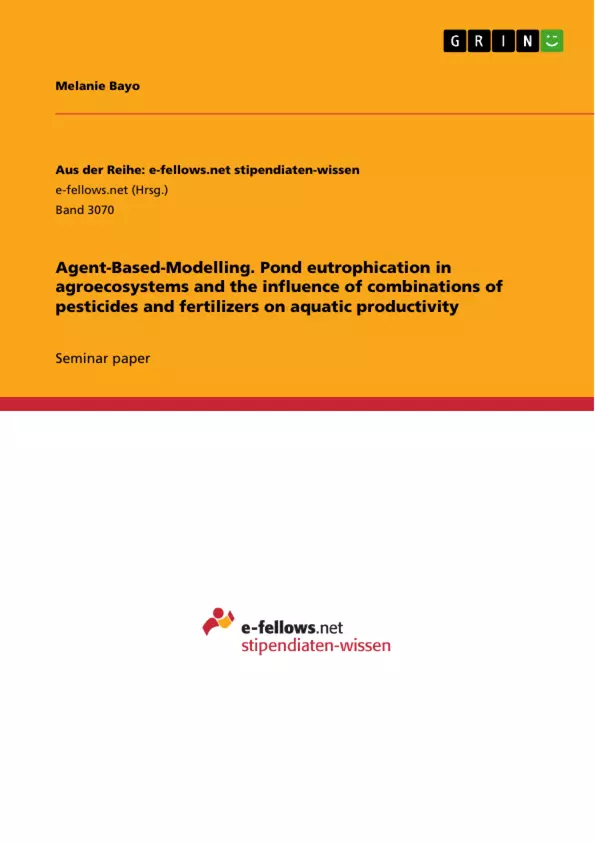The paper asks, if ponds located in agroecosystems can be prevented from tipping over by variation in combinations of fertilizers and pesticides. Through a simulation in NetLogo, an agent-based programmable modeling environment, the interplay of two pesticides (Cypermethrin and Malathion) and a fertilizer (Nitrogen + Phosphate) and their effect on the aquatic productivity is observed.
The model depicts an agroecosystem with three separate fields and two ponds. The model is simplified by assuming consistent environmental conditions and narrowing down the pond population to one zooplankton species and one phytoplankton species (Chlorella vulgaris). Through variation of variables different scenarios are generated.
The research revealed that input of pesticides – even without fertilizers which are known for supporting phytoplankton growth – results in eutrophication through decreasing zooplankton population and therefore blooming phytoplankton population. The original contribution of the simulation is in revealing that beyond the amount of chemical substances used in farming, the variation of input is also to consider, since certain ones may have greater negative effects than assumed so far.
Inhaltsverzeichnis (Table of Contents)
- Abstract
- 1. Introduction
- 2. Material and Methods
- 2.1 Purpose
- 2.2 Entities, state variables and scales
- 2.3 Process overview and scheduling
- 2.4 Design concepts
- 2.5 Initialization
- 2.6 Input data
- 3. Results
- 4. Discussion
- 5. List of References
Zielsetzung und Themenschwerpunkte (Objectives and Key Themes)
This research paper investigates the impact of pesticide and fertilizer combinations on aquatic productivity in ponds located within agricultural ecosystems. The paper utilizes an agent-based model to simulate the interaction of two pesticides (Cypermethrin and Malathion) and a fertilizer (Nitrogen + Phosphate) on the populations of zooplankton and phytoplankton. The research aims to determine if varying combinations of these chemicals can prevent ponds from experiencing eutrophication.
- The impact of pesticide and fertilizer combinations on aquatic productivity.
- The influence of these chemicals on zooplankton and phytoplankton populations.
- The potential for different combinations to mitigate eutrophication.
- The role of agent-based modeling in simulating complex ecological interactions.
- The comparison of model results to real-world observations.
Zusammenfassung der Kapitel (Chapter Summaries)
The research paper begins with an introduction highlighting the increasing use of synthetic fertilizers and pesticides in modern agriculture and their detrimental effects on agroecosystems. This section emphasizes the role of pesticides and fertilizers in contributing to eutrophication in aquatic ecosystems.
The "Material and Methods" section details the design and implementation of the agent-based model. It outlines the entities, state variables, and scales involved in the simulation, as well as the process overview, scheduling, design concepts, initialization, and input data used in the model. The section also discusses the model's reliance on real-world data and its limitations.
The "Results" section presents the findings of two scenarios. The first scenario investigates the effects of pesticide input with the use of fertilizer, while the second scenario explores the effects of pesticide input without fertilizer. This section provides data tables and graphs illustrating the population dynamics of zooplankton and phytoplankton, nutrient content, and oxygen saturation in the ponds over time.
The "Discussion" section analyzes the results of the two scenarios and compares them to findings from previous studies. It addresses the limitations of the model and potential future directions for research, including incorporating more complex ecological interactions and exploring the long-term effects of pesticide and fertilizer combinations on pond ecosystems.
Schlüsselwörter (Keywords)
The key themes and concepts covered in this research paper include eutrophication, agent-based modeling, pesticide application, fertilizer use, agricultural ecosystems, pond productivity, zooplankton populations, phytoplankton populations, aquatic ecosystems, and environmental impact.
- Arbeit zitieren
- Melanie Bayo (Autor:in), 2018, Agent-Based-Modelling. Pond eutrophication in agroecosystems and the influence of combinations of pesticides and fertilizers on aquatic productivity, München, GRIN Verlag, https://www.grin.com/document/468575



